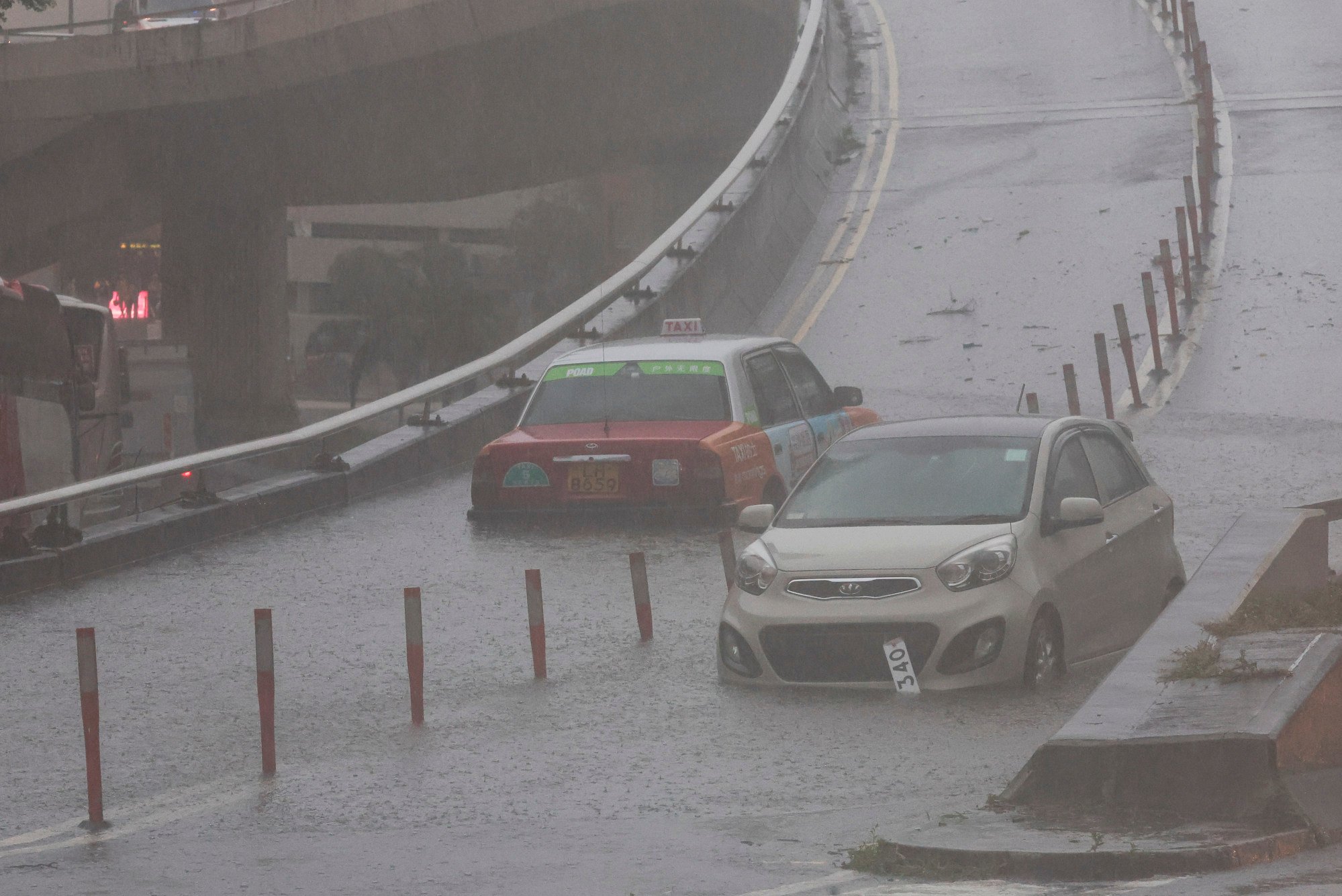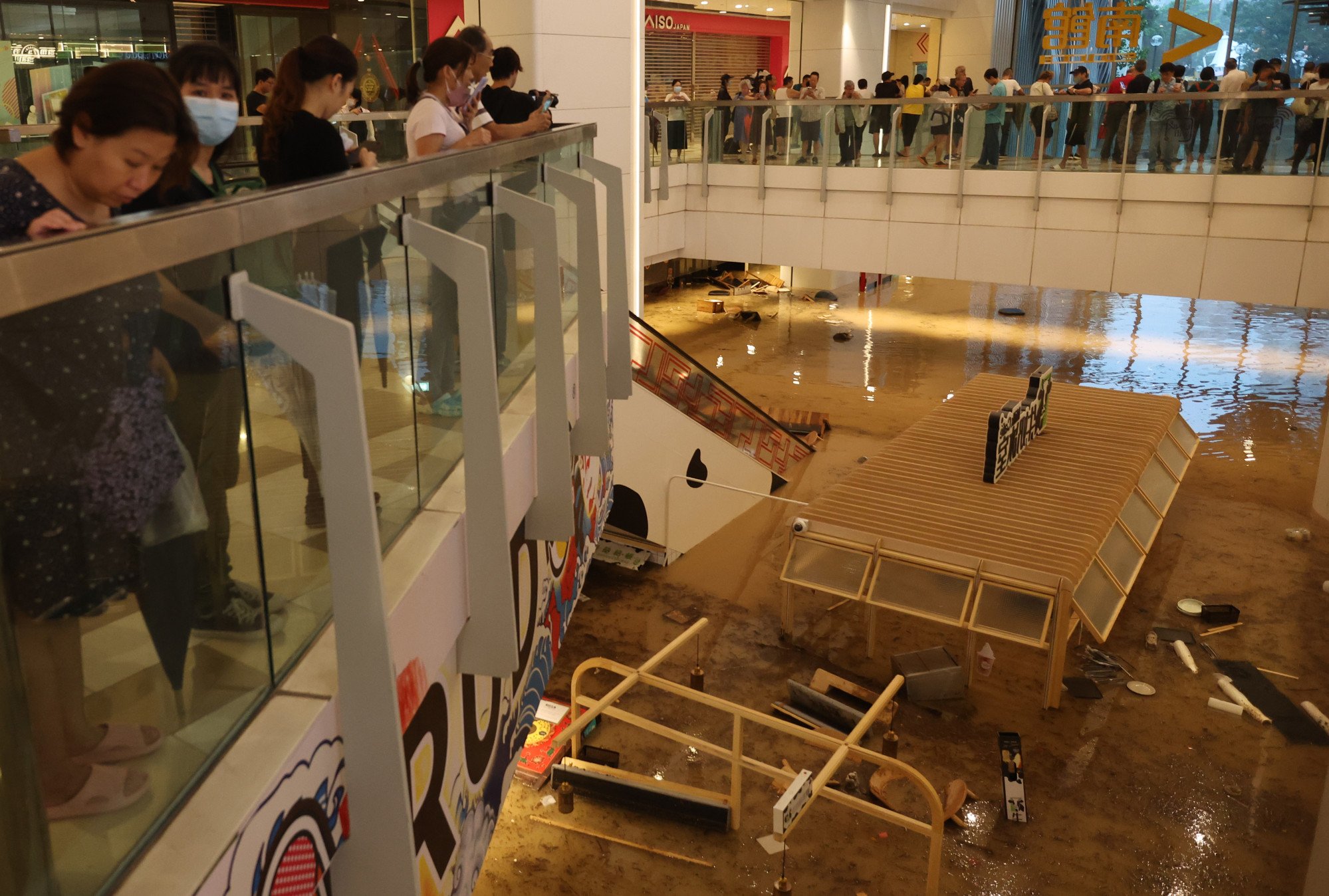
Hong Kong wakes to chaos in urban areas as downpour under black rainstorm warning sparks flooding, landslides
- Downpour brings city to standstill with reports of roads sinking, drivers being stranded in vehicles and a mall restaurant becoming submerged
- Urban areas hard hit; authorities receive at least 39 reports of landslides
Residents in urban areas woke to serious flooding and damage caused by torrential rain under the first black rainstorm warning in almost two years on Friday, with most reported landslides hitting Hong Kong Island.
The downpour brought the city to a standstill in the morning as roads subsided, drivers were left stranded in cars, restaurants flooded and landslides struck near residential estates.
Images of people turning plastic road dividers into makeshift rafts or stranded on car roofs were circulated on the internet.

The black rainstorm alert issued at 11.05pm on Thursday lasted for more than 16 hours, breaking the city’s records for the longest signal of its kind and for the largest amount of rainfall recorded in one hour. The Observatory headquarters logged 158.1mm (6.2 inches) of rain between 11pm and midnight on Thursday, the highest since records began in 1884.
In Wong Tai Sin, not a usual flooding black spot, the Post observed that muddy water had almost covered the entire lower ground floor of Temple Mall North.
Hong Kong under black rain alert, extreme weather to last till 6pm at least
One restaurant in the shopping centre was submerged, leaving only the top of its stall above the water as debris and chairs floated next to it.
Link Asset Management, the operator of the shopping centre, said on-site observations indicated that the main cause of the flooding was rainwater flowing from higher ground into the basement of the complex.
The company said water was being pumped out from the centre and repairs under way so normal service could be restarted as soon as possible.
But a spokesman said: “It may take a few days for tenants on the lower ground floor to resume their operations.”
Water also poured into an MTR station nearby, which cut off access to the stairs at the entrance.
Hong Kong floods: a Post editor’s account of traffic chaos amid monster downpour
Lung Cheung Road, the major route through the area, was flooded outside the mall with workers left to wade through the water with their legs fully submerged. Online footage showed a car floating through the area.
Wong Tai Sin resident Vickie Wong Wai-kei, 40, a school administrator, who was allowed to work from home on Friday, said she could barely continue after she reached Lung Cheung Road, a minute’s walk away from her home.
Leader agrees on need for warning system review for storm-battered Hong Kong
Wong, who lived with her husband in Fire Services Department staff quarters in Ying Fung Lane, went out in the morning at about 9.45am and said she was shocked by the devastation.
“It’s literally a disaster as water has flooded the street, reaching knee level. People are still able to wade through slowly, but this section of Lung Cheung Road is slightly sloped, making it look like a fast-flowing river, which is quite daunting,” Wong said.
She added there was no way to get any nearer to the MTR station.
“I saw parents carrying their children on their backs as they walked across the pedestrian bridge towards Temple Mall North. Some people seem a bit lost and confused about what direction they should go,” she said.
The extreme conditions also affected Hong Kong Island. A car park at the Wan Tsui Estate in Chai Wan was half-filled with water in the morning, almost fully covering vehicles.
Tin Lok Lane in Wan Chai, a busy area filled with traffic and pedestrians in normal conditions, had turned into a river.

Some drivers complained they were trapped overnight and multiple cases of road subsidence were reported.
Morrison Hill Road in Causeway Bay also experienced flooding on Thursday night, leaving shops selling lighting products covered with mud and knocking down lamps. Staff were seen mopping the floors and pouring water out of the stores on Friday.
A shop owner in his 50s, surnamed Kan, said he was only able to return to his shop at noon on Friday due to the bad weather and the water had left half-a-meter long marks in the store, ruining half of his lights and clocks that cost several hundred thousand dollars.
Typhoon Saola leaves debris, fallen trees on Hong Kong roads, but impact small
“The loss is huge. It could take us a year to cover the losses. Business has been mediocre as the economy has yet to recover,” he said, adding that he was unsure how much repairs would cost.
“The government did a poor job as it failed to notify us earlier so that we could be prepared.”
A dried seafood shop located in the nearby Bowrington Road Market was luckier as manager Sam Tam drove back in the early hours of Friday to move dried scallops and fish maw to higher spots in the shop after checking footage of the flooding captured by surveillance cameras.
“We sell relatively pricey products. We would not be able to keep them any more if they were soaked in water for the whole night,” Tam said.
“Luckily, I had not slept yet. Or else, we would lose tens of thousands of dollars instead of several thousand dollars.”
Ten cases of road subsidence were reported between Thursday night and Friday afternoon, all on Hong Kong Island, affecting areas such as Stanley, Aberdeen and Chai Wan.

Online photos and footage showed a car had fallen into a cavity that formed as ground gave way at the junction of Island Road and Repulse Bay Road.
Kandice Chan, 30, who has lived in an area above Wan Tsui Estate her entire life, said she had never seen flooding on such a scale in the area.
She said she was fortunate that she was able to arrive home at about 10.30pm, before the flooding worsened.
“On my minibus ride back home … I saw a sewage cap was detached and the water was bursting out. It was like a disaster movie, but at an early stage because the clips I watched after getting home were the scariest,” the corporate communications officer said.
“The current of the water flowing on pedestrian roads and traffic lanes was quite strong. It was like I was travelling on a rapid or a waterfall.”
Denis Chan, a 28-year-old bank worker, said it took him two hours to travel home from Hung Hom to Siu Sai Wan on Thursday night.
“My bus travelled from North Point to Siu Sai Wan through King’s Road and the whole area was flooded. Water also leaked into some noodle shops,” he said.
“When we got to Chai Wan, which was severely affected, the cars were not travelling on the original lanes where many other cars had broken down and were blocked by debris.”

Stuart Hargreaves, a law professor from Chinese University, revealed in a social media post that he had been stranded in his car overnight in Repulse Bay as the road he was taking to head home had been submerged.
“It was scary … water was coming over the hood of the car and I thought it was going to flood the engine,” he told the Post. “Luckily I managed to avoid that and pulled over to a slightly elevated car park near Repulse Bay Beach.”
The government received at least 39 reports of landslides. Among them was a landslide on Yiu Hing Road in Shau Kei Wan, near Yiu Tung Estate. Large rocks, trees and debris were washed from the slope, blocking the entire road.
Water supply at five of the 11 blocks of the estate was suspended on Friday afternoon.
Cheung Mei-sheung, 65, a retiree living in Yiu Kwai House in Shau Kei Wan, said the landslide was terrifying as her daily commute involved getting off the bus beneath the slope every evening after taking care of her granddaughter in Sai Wai Ho.
“Thank goodness it happened in the middle of the night. It would have been devastating if the slope fell before midnight. My family members all said I was blessed by the Buddha,” she said.
Simon Wong Ka-wo, president of the Hong Kong Federation of Restaurants and Related Trades, told a radio show on Friday morning that his car broke down when he was on the way to Deep Water Bay with his daughter.
“The water almost covered the entire front part of my car,” Wong said. “When we left the car, the water was gushing in like a flood as we opened the door.”
Good communication and lessons learned ‘spared Hong Kong the worst of Saola’
They were taken to Ocean Park MTR station for shelter and stayed there for at least eight hours.
The government has received reports of at least 130 stalled cars since Thursday night. Half of them, in particular those on major throughways, were relocated before Friday afternoon.
An employee at a towing company based in Yuen Long said they had received about 70 calls for assistance by 1.30pm on Friday, but were only able to rescue 12 vehicles due to their limited fleet of tow trucks and hazardous road conditions.
Floods also struck villages across the city. On Lamma Island, paths were seen fully submerged at one village, which made it difficult for people to leave or enter their houses.
The water turned into raging rapids at a section of Shing Mun River near Mei Lam Estate.

Ko Wai-kei, a North district council member, said that flooding was serious in Sha Tau Kok and Ta Kwu Ling, where his constituencies were located.
He said he believed the floods had been partly exacerbated by the build-up of leaves and debris in drainage systems following Super Typhoon Saola, which struck last week.
“The government might not have had enough time to clear the build-up afterwards, and so the drainage capacity would be affected if there was heavy rain,” Ko said.
Additional reporting by Connor Mycroft, Oscar Liu and Lars Hamer



